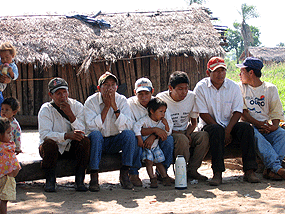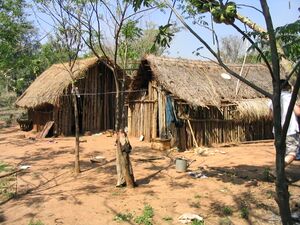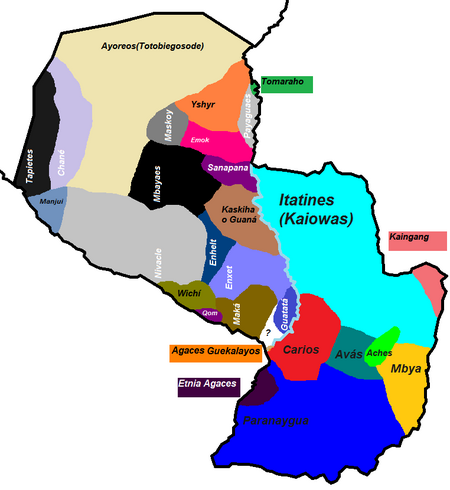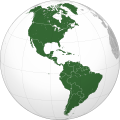الشعوب الأصلية في باراغواي
الشعوب الأصلية في پاراگواي تضم 17 جماعة عرقية belonging to five language families.[1][2] While only a 1.7% of Paraguay's population is fully indigenous, 75% of the population identifies as being partially of indigenous descent;[3] however, the majority do not identify as being indigenous but as Mestizos. Most of the native population lives in the northwestern part of the country, the Gran Chaco.
التعداد
The Second National Indigenous Census, conducted in 2002, recording approximately 87,099 people, or 1.7% of the country's population, as being indigenous;[1] however, as many as 75% of the Paraguayan population is mestizo, that is of partial Amerindian descent.[3] Since the late 20th century, the indigenous population is growing faster than the rest of the population. As of 2002, 47.1% of the native population was 14 years old or younger.[1]
الاستيطان
An increasing percentage of the registered indigenous population lives in the northwestern region of Paraguay. The 1981 census reported 32.8% of the indigenous peoples living there, while 44.2% lived there in 1992, and 50.7% in 2002. The majority of indigenous peoples live in rural areas in 412 indigenous communities.[1]
Indigenous reserves are in place to protected uncontacted peoples and other isolated communities.[4]
اللغات
Indigenous Paraguayan languages belong to five language families: Guarani, Guaycuru, Maskoy, Mataco-Mataguayo, and Zamuco.[1] The Guarani language, along with Spanish, is an official language of Paraguay and is spoken by 90% of the population.
القضايا الاجتماعية
Literacy rates are low among indigenous peoples in Paraguay, who have an illiteracy rate of 51% compared to the 7.1% rate of the general population.[1]
Access to clean drinking water is a major challenge. Only 2.5% of Paraguay's indigenous population has access to drinking water and only 9.5% have electricity.[1]
القبائل
توزيع الشعوب الأصلية حسب القسم الإداري:
| القسم | التعداد (إحصاء 2022)[5] |
|---|---|
| Presidente Hayes | 29 814 |
| Boquerón | 29 774 |
| Canindeyú | 16 294 |
| Caaguazú | 13 255 |
| Amambay | 12 439 |
| آلتو پارانا | 8 915 |
| Caazapá | 5 290 |
| سان پدرو | 4 641 |
| Alto Paraguay | 4 414 |
| Concepción | 3 645 |
| إيتاپوا | 3 494 |
| Central | 3 069 |
| گوايرا | 1 928 |
| أسونسيون | 419 |
| Paraguarí | 116 |
| الإجمالي | 137 507[6] |
انظر أيضاً
Notes
- ^ أ ب ت ث ج ح خ "Paraguay." Pan-American Health Organization. (retrieved 12 July 2011)
- ^ أ ب ت ث ج "Paraguay." Countries and Their Cultures. (retrieved 12 July 2011)
- ^ أ ب "Paraguay: Ethnic Groups." CIA: The World Factbook. (retrieved 12 July 2011)
- ^ Dimitri Selibas (5 July 2023). "Bill stripping Peru's isolated Indigenous people of land and protections scrapped". Mongabay. Retrieved 7 July 2023.
- ^ خطأ استشهاد: وسم
<ref>غير صحيح؛ لا نص تم توفيره للمراجع المسماةindígena - ^ No se incluyen las 2699 personas captadas por el Censo Nacional a no indígenas.
- ^ أ ب ت ث ج ح خ د ذ ر ز "Native American Tribes of Paraguay." Native Languages. (retrieved 12 July 2011)
وصلات خارجية
- Instituto Paraguayo del Indigena (in إسپانية)
- "Paraguay's Indigenous Peoples in Peril", Amnesty International
- Assessment for Indigenous Peoples in Paraguay
- Indigenous Squatter Communities Organise Self-Help, InterPress Service Agency





